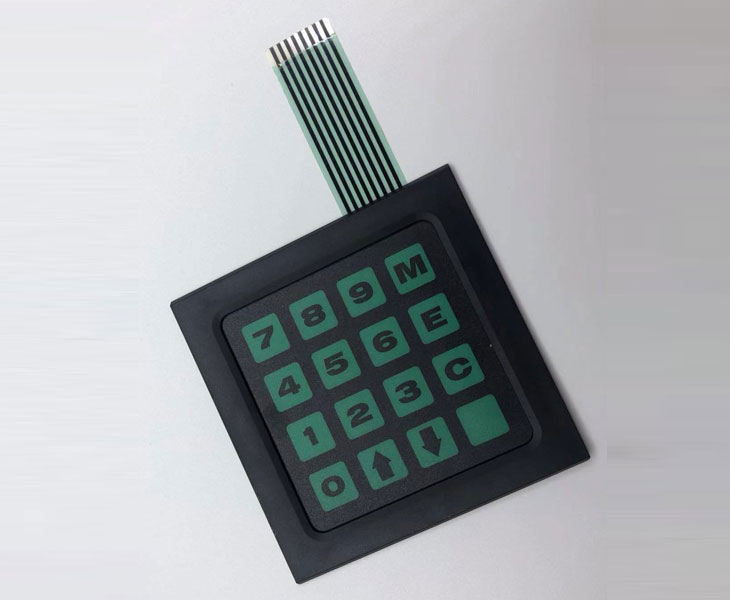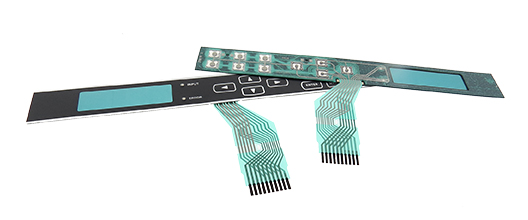The evolution of membrane switch in aerospace engineering
Comprehending the Relevance of Membrane Change in Modern Electronics
Membrane switches are important parts in modern-day electronic gadgets. They offer a blend of capability and style that improves individual interaction. Their lightweight and durable nature makes them suitable for numerous applications. As industries develop, the demand for modification and progressed attributes expands. Comprehending how membrane layer switches over contribute to innovation discloses their relevance in shaping the future of electronic devices. What lies ahead for this technology?
The Basics of Membrane Layer Change Technology
Typically overlooked, membrane button innovation plays an essential duty in the contemporary electronic devices landscape. These devices, made up of several layers, function as individual interfaces for numerous electronic items, varying from home appliances to clinical devices. A typical membrane layer switch includes a graphic overlay, a spacer layer, and a circuit layer, which are thoroughly assembled to create a useful interface.When pressure is related to the overlay, the circuit layer is completed, permitting signals to be transmitted to the gadget. This modern technology is understood for its flexibility, making it possible for personalization in shape, performance, and style to satisfy details individual needs. In addition, membrane buttons are light-weight and thin, making them suitable for applications where area is a costs. Their toughness and resistance to ecological factors additionally enhance their appeal, guaranteeing they can endure rough problems while keeping performance. On the whole, membrane button modern technology is indispensable to creating user-friendly and efficient electronic gadgets

Secret Advantages of Membrane Switches
Membrane layer changes offer a number of essential benefits that make them a recommended choice in numerous digital applications. Their design allows for a portable type element, making it possible for manufacturers to create smooth and lightweight gadgets. Additionally, membrane layer switches are resistant to dirt, moisture, and chemicals, which boosts their toughness and durability popular atmospheres. The responsive comments given by these switches can boost user experience, making them intuitive and easy to operate.Furthermore, membrane layer switches can be personalized with varied graphics and shades, enabling distinct branding possibilities. The manufacturing procedure is usually affordable, specifically for high-volume manufacturing, as it minimizes setting up time and simplifies style. Finally, membrane layer switches need marginal maintenance, adding to lower general functional prices. These benefits highlight their expanding popularity in contemporary electronic devices, where integrity and easy to use user interfaces are essential.

Applications Throughout Different Industries
The flexibility of membrane switches over enables their widespread fostering throughout numerous sectors. In the medical area, they are typically used in analysis tools and person tracking systems, offering a long lasting interface resistant to contaminants. The automotive sector utilizes membrane buttons for dashboard controls, improving individual experience with streamlined styles that hold up against harsh conditions. In consumer electronic devices, they serve as control panels for tools such as microwaves and coffee machine, supplying an easy to use user interface that is easy to tidy. The aerospace field employs membrane layer switches in cockpit controls, where integrity and area efficiency are vital. In addition, the industrial sector leverages these buttons in equipment and control systems to guarantee robust procedure sought after atmospheres. This wide series of applications emphasizes the flexibility of membrane anonymous layer switches, making them essential elements in improving capability and customer communication across diverse technological landscapes.
Modification and Style Adaptability

Future Patterns in Membrane Layer Switch Development
Arising patterns in membrane layer button advancement indicate an expanding emphasis on boosted performance and combination with smart modern technologies. As customer demand for a lot more advanced electronic devices boosts, suppliers are concentrating on producing membrane switches that not just offer standard functional roles yet additionally include attributes like touch level of sensitivity, backlighting, and haptic feedback.Furthermore, developments in products are expected to boost sturdiness and environmental resistance, making membrane switches over suitable for varied applications in industries such as health care, automotive, and consumer electronic devices. The assimilation of capacitive touch modern technology is likely to become a lot more widespread, enabling sleeker designs and improved user interfaces. membrane switch.Additionally, the rise of the Web of Things (IoT) is prompting the advancement of membrane layer switches over that can interact wirelessly with other devices, enhancing interconnectivity. On the whole, the future of membrane button innovation appears encouraging, driven by technology and the pursuit of straightforward solutions
Frequently Asked Concerns
Just How Do Membrane Switches Over Compare to Typical Mechanical Switches?
Membrane switches, being much more space-efficient and using a smooth design, comparison with conventional mechanical switches that provide tactile comments. The former usually include adjustable graphics, while the latter usually guarantee longevity and integrity in various applications.
What Products Are Typically Utilized in Membrane Layer Switch Over Production?
Membrane switches are normally produced making use of materials such as polyester, polycarbonate, and printed conductive inks. These products offer durability, responsiveness, and best site flexibility, making them suitable for numerous applications in electronic devices and interface.
Can Membrane Changes Be Fixed or Recycled?
Membrane buttons can frequently be fixed, especially if minor issues emerge, such as sticky failing or surface area damage. However, full reuse is typically restricted because of wear and potential destruction of products gradually.
How Do Environmental Aspects Impact Membrane Layer Change Efficiency?
Ecological elements, such as direct exposure, temperature level, and moisture to chemicals, significantly influence membrane layer switch efficiency. Extreme problems can cause deterioration, influencing responsiveness and longevity, ultimately endangering the capability of the device in different applications.
What Is the Common Life-span of a Membrane Switch?
The normal life expectancy of a membrane layer switch typically varies from 1 to 5 million actuations, depending on elements such as use regularity, ecological problems, and the materials used in production, impacting longevity and performance longevity. A regular membrane switch consists of a visuals overlay, a spacer layer, and a circuit layer, which are thoroughly assembled to produce a useful interface - membrane switch.When stress is used to the overlay, the circuit layer is completed, allowing signals to be transferred to the gadget. The responsive comments given by these switches can enhance individual experience, making them user-friendly and very easy to operate.Furthermore, membrane switches can be customized with varied graphics and shades, permitting for unique branding opportunities. As customer need for extra innovative digital tools increases, manufacturers are focusing on creating membrane layer switches that not just offer standard functional duties but also include attributes like touch level of sensitivity, backlighting, and haptic feedback.Furthermore, developments in materials are expected to boost durability and environmental resistance, making membrane layer switches suitable for varied applications in sectors such as health care, vehicle, and customer electronic devices. The combination of capacitive touch technology is likely to come to be a lot more widespread, permitting for sleeker styles and enhanced user interfaces.Additionally, the increase of click here to find out more the Web of Points (IoT) is prompting the development of membrane changes that can communicate wirelessly with other gadgets, improving interconnectivity. Membrane buttons, being a lot more space-efficient and providing a sleek style, comparison with typical mechanical switches that supply tactile responses